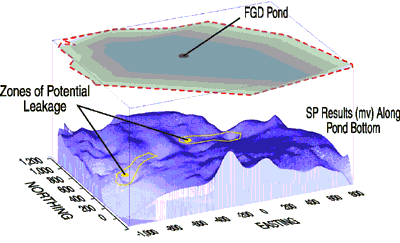
-
- Investigation
and Design Assistance
Flue Gas Desulfurization Ponds
State of Wyoming
Situation
Several
holding ponds, including a 40-acre flue gas desulfurization
(FGD) pond, had leaked into aquifers underlying a coal-fired
power plant. The only groundwater data available had been
collected after pond leakage had affected area water levels.
Hydro Geo Chem was retained to define the impacts
of FGD pond leakage and to determine operational and remedial
alternatives.
Hydro
Geo Chem's Approach
We
established the extent of FGD and other pond leakage by
reconstructing the aquifers' historical flow fields by means
of a 3-dimensional transient inverse model, by installing
wells and conducting aquifer and tracer tests to determine
aquifer parameters, by employing stable isotopes to identify
the contributions from the various pond sources, by a spontaneous
potential and seep-meter leakage survey of the FGD pond,
and by modeling the fate and transport of salts from the
ponds. We then used these models to predict the FGD pond
lifetime and to assist in the design of a 300-acre replacement
FGD pond.
Results
We
found that the aquifer areas affected by the FGD saline
plume had stabilized and would disappear after plant operations
had ceased. We concluded that no remediation was necessary.
These conclusions were presented to and accepted by the
Wyoming Department of Environmental Quality (DEQ). We also
determined that the new pond would not significantly increase
the aquifer area affected by seepage, and that the clay
liner originally part of the pond design provided no additional
protection. Our recommendations were incorporated into the
new pond design, which was accepted by the Wyoming DEQ.
A savings of $15 million was realized by not installing
this liner.

Figure: Self-Potential (SP) Survey of FGD Pond Bottom
-